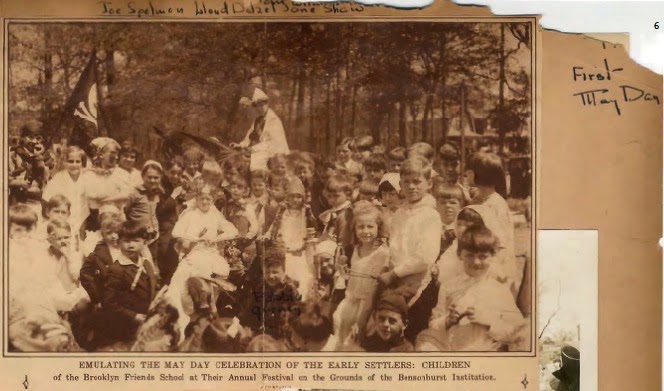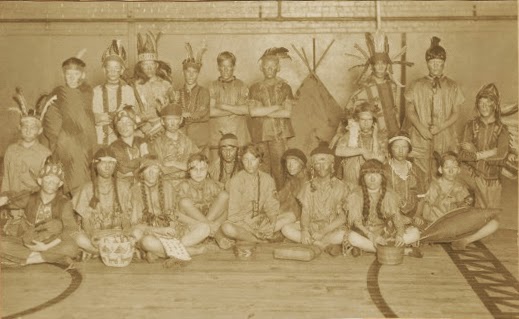Facing Truth in BFS History

 |
| 1928-1936 BFS Lower School Scrapbook, news clipping of the first May Day, 1928 “Emulating the May Day Celebration of the Early Settlers…” |
Sometimes history reveals a past that is not always what we want it to be, even at BFS. A few months back, I wrote about our school’s path to enrolling students of color, particularly to enrolling African American students. Honesty in researching, interpreting and presenting history frees us from the fallacy of unintentional reinvention while it gives us greater understanding of ourselves. My historical work at BFS often reminds me of the West African Akan word “Sankofa” which means, “We must go back and reclaim our past so we can move forward; so we understand why and how we came to be who we are today.” I first came to know and appreciate the concept behind Sankofa when I worked as a historical researcher for the African Burial Ground Office of Public Information and Interpretation many years ago.
A case in point is the 1928-1936 BFS Lower School Scrapbook, just published to the BFS Digital Archives this week. This crumbling volume was discovered in the BFS Archives many years ago and it seems to have been kept by Miss May A.K. Gorham, head of our lower school from 1927 to at least 1942. The scrapbook is an incredible document of a period in our school’s history for it gives a glimpse of everyday life in the lower school through newspaper clippings, student writing and art, and many photos. Our school does not have many such items since our BFS forebears did not always keep items we would love to have in the Archives now and, as happens today, they could not always make time for keeping such a record of daily life at BFS.
 |
| News clipping of the 1932 Fire |
Among many moments, the scrapbook documents the first BFS May Day celebration at Friends Field in 1928 and the November, 1932 fire. It gives insights into the Mother’s Club’s annual fairs which helped BFS raise funds to serve both the school’s needs and the needs of others in the Brooklyn community, very often for the Little Friends Kindergarten, the free kindergarten our school and Mother’s Club founded in the 1910s to help make kindergarten education accessible to many in Brooklyn. The student work gives evidence of our school’s past curriculum, of which little is known since any school’s curriculum is ever-changing.
Unfortunately, a few of the scrapbook’s photos show BFS students in plays wearing costume and make-up and so provide unyielding evidence of our school’s racially insensitive past. It is very possible these students were learning of other cultures and such plays were part of the curriculum. However, applying make-up to appear to be a member of another race may have been acceptable in such circumstance 75 or 85 years ago, but it is unacceptable today. The photos in question are now offensive even when tempered by the notion that “things were different” in earlier times or when considering the idea that theater gives in-depth opportunity to explore aspects of life outside of oneself (classic opera comes to mind). This scrapbook’s importance lies in seeing our past for what it was, gaining better understanding of who we are today, and even so we may experience how proudly our school once wore its own ignorance, disrespect and hypocrisy. The decision to publish this scrapbook without editing out such photographs took years and included discussions with students, alumni, colleagues, and the BFS Diversity Office.
 |
| Circa-1930 BFS students portrayed Native Americans |
The offensive photos represent a very small portion of an amazing document, yet they diminish it. I hope we can try to view the scrapbook as an unveiled look into our school’s past as we acknowledge its imperfections. I wrote an introduction for the scrapbook which appears on the first page of the PDF. The introduction offers explanation of the contents and layout, but it also includes this paragraph solely concerning the scrapbook’s offensive photos:
This scrapbook contains several photographs of what appear to be performances of plays in which BFS students portrayed members of other races through the use of make-up, something that is now deemed racially insensitive and offensive. These early 20th Century photographs show past moments when racism was more apparent, everyday, and widely accepted in our society and even, it seems, in our school. These photographs have been included in the interest of being honest in presenting our school’s history. The past will never be changed, but understanding and learning from the past deeply affects our future.
Today, we are very grateful for changes in our school and in our world, but our gratitude is incapable of changing the fact that we can never change history. We can also be grateful that we have items like this scrapbook so we can more fully appreciate our past, present and future.
Note: Due to size constraints, the online PDF of the 1928-1936 BFS Lower School Scrapbook is lower resolution. A higher resolution PDF of the scrapbook is available upon individual request. The original scrapbook remains in the school’s archives, but its fragile condition limits future physical handling.
